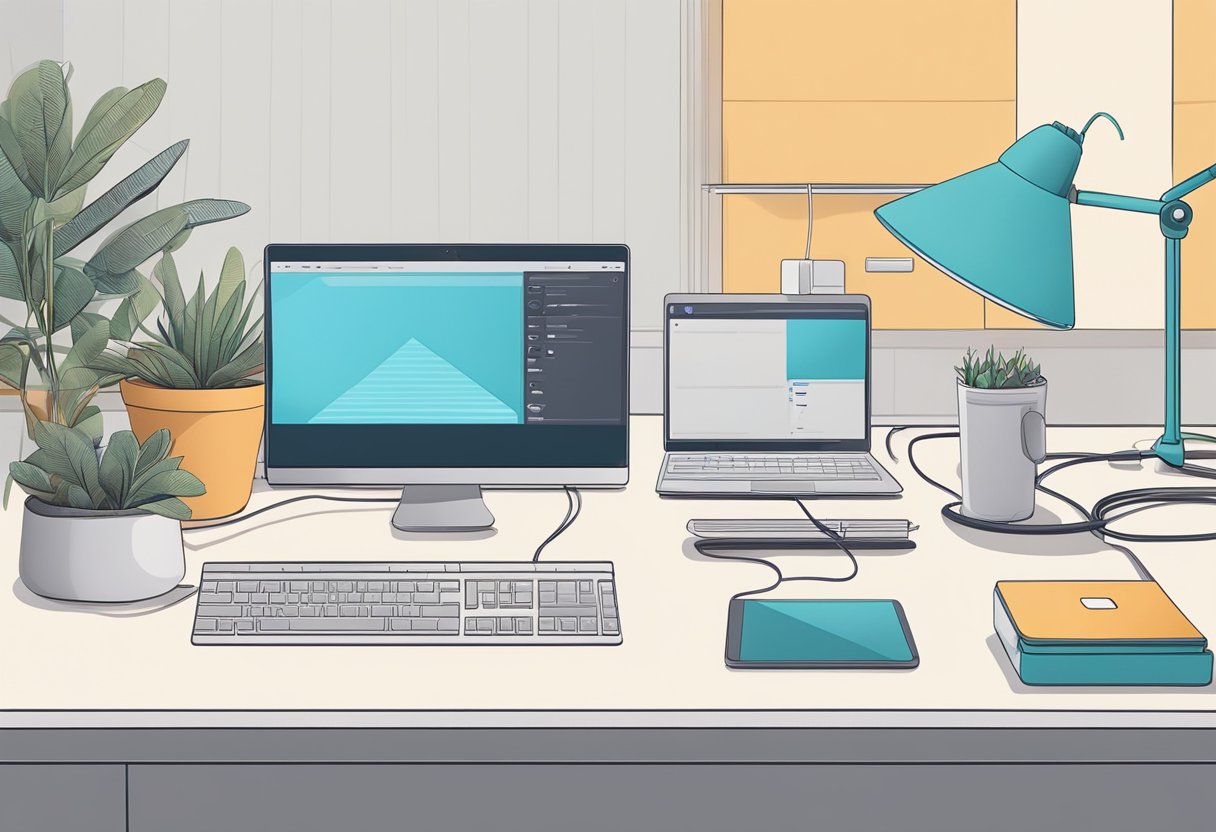Keeping your devices running smoothly is essential for productivity and efficiency. Whether you use a computer, smartphone, or tablet, it can be frustrating when your device starts to slow down or experience issues. Fortunately, there are several simple steps you can take to keep your devices running smoothly and avoid common problems.

One of the most important things you can do to keep your devices running smoothly is to keep them updated. This includes both software updates and hardware updates, such as installing new drivers or replacing old components. Updates often include important security patches and bug fixes, which can help prevent issues and improve performance. Additionally, keeping your device clean and free of dust and debris can also help prevent overheating and other problems.
Another key factor in keeping your devices running smoothly is to be mindful of how you use them. This includes avoiding overloading your device with too many open applications or browser tabs, which can slow down performance. Additionally, taking steps to optimize your device’s settings and configurations can help improve performance and extend battery life. With these simple tips and tricks, you can keep your devices running smoothly and avoid common issues that can interfere with your productivity and enjoyment.
Understanding Your Device

To keep your device running smoothly, it’s important to understand its hardware and software. Devices such as computers, phones, and tablets have different components that work together to perform various tasks.
First, let’s talk about the hardware. Devices have a central processing unit (CPU) that controls the device’s functions. The CPU is responsible for executing instructions and performing calculations. The amount of processing power your device has depends on the CPU’s speed and the amount of random-access memory (RAM) it has. More RAM means your device can handle more tasks at once without slowing down.
Second, let’s talk about the software. Devices run on an operating system (OS) such as Windows, Android, or iOS. The OS is responsible for managing the device’s hardware and software. It controls how programs access hardware resources and how they interact with each other. Keeping your OS up-to-date is important to ensure your device runs smoothly.
In addition to the hardware and software, it’s important to understand the limitations of your device. Every device has a maximum capacity for storage, processing power, and memory. Overloading your device with too many programs or files can slow it down. It’s important to regularly clean up your device by deleting unnecessary files and programs.
Overall, understanding your device’s hardware, software, and limitations is key to keeping it running smoothly. Regular maintenance such as updating your OS and cleaning up your device can help prolong its lifespan.
Optimizing Device Settings
https://www.youtube.com/watch?v=RyT5n8HD9Wk&embed=true
To ensure that your device is running smoothly, it is important to optimize its settings. This section will cover some of the key settings that you should adjust to improve your device’s performance.
Adjusting Display and Power Settings
Adjusting your device’s display and power settings can help to improve its performance and extend its battery life. To adjust these settings, go to the settings menu and select “System.” From there, you can adjust the display brightness, screen timeout, and other power-related settings.
Managing Notifications and History
Managing your device’s notifications and history can also help to improve its performance. To manage notifications, go to the settings menu and select “Notifications & actions.” From there, you can turn off notifications for specific apps or adjust how notifications are displayed.
To manage your device’s history, go to the settings menu and select “Privacy.” From there, you can clear your browsing history, location history, and other types of data that may be slowing down your device.
Configuring Security and Privacy Settings
Configuring your device’s security and privacy settings is also important for keeping it running smoothly. To configure these settings, go to the settings menu and select “Update & Security.” From there, you can manage your device’s antivirus software, firewall, and other security settings.
You can also manage your device’s privacy settings from this menu, including settings related to your camera, microphone, and other sensors.
Overall, optimizing your device’s settings can go a long way in improving its performance and extending its lifespan. By adjusting your display and power settings, managing your notifications and history, and configuring your security and privacy settings, you can ensure that your device is running smoothly and securely.
Maintaining Software and Applications
https://www.youtube.com/watch?v=LEgCj6jMdyQ&embed=true
Keeping software and applications up-to-date is essential for maintaining the smooth running of your device. Outdated software can cause performance issues and leave your device vulnerable to security threats. In this section, we will cover the best practices for updating and troubleshooting software and managing applications.
Updating and Troubleshooting Software
Regularly updating software is crucial for keeping your device running smoothly. Updates often include bug fixes, security patches, and new features that improve performance and functionality. To ensure that your software is up-to-date, check for updates regularly or enable automatic updates.
If you encounter issues with software, troubleshooting can help resolve the problem. Troubleshooting involves identifying the cause of the issue and finding a solution. Windows 11 and Windows 10 both have built-in troubleshooting tools that can diagnose and fix common issues. Windows Update can also help resolve software issues by installing the latest updates and drivers.
Managing Applications
Managing applications is another critical aspect of maintaining your device’s performance. Installing too many applications can slow down your device and cause it to run out of storage space. To manage applications, regularly uninstall apps that you no longer use or need.
Additionally, keeping your applications organized can help improve performance. Grouping similar applications together can make them easier to find and help you avoid cluttering your device’s home screen. If you’re using an Android device, the Google Play Store has a “My apps & games” section that displays all installed apps and allows you to sort them by various criteria.
Finally, be mindful of the applications you install. Malware and other malicious software can cause significant performance issues and put your device’s security at risk. Only install applications from trusted sources and enable security features such as antivirus software to protect your device.
By following these best practices for maintaining software and applications, you can help ensure that your device runs smoothly and stays secure.
Enhancing Device Performance
https://www.youtube.com/watch?v=Skm6U0LdHU8&embed=true
When it comes to enhancing device performance, there are a few key areas to focus on. Managing memory and storage, optimizing battery life, and improving the device’s performance are all crucial to keeping your device running smoothly.
Managing Memory and Storage
One of the most important factors in device performance is available memory and storage. Running too many programs at once or having too many files stored on the device can slow it down significantly. To manage memory and storage effectively, users should regularly clean up their device by deleting unnecessary files and programs. Another helpful tip is to use the task manager to monitor memory usage and close programs that are not in use.
Virtual memory is also an important aspect of managing memory and storage. By increasing the size of the virtual memory, users can improve their device’s performance. This can be done by going to the system properties and adjusting the virtual memory settings.
Optimizing Battery Life
Battery life is a critical aspect of device performance, especially for mobile devices. To optimize battery life, users should adjust their device’s settings to conserve power. This can include turning off unnecessary features such as Bluetooth and Wi-Fi when not in use, reducing screen brightness, and enabling power-saving modes.
Another helpful tip is to avoid using resource-intensive programs when the battery is low. These programs can drain the battery quickly and cause the device to slow down.
Improving Device’s Performance
Improving the device’s performance involves a combination of managing memory and storage, optimizing battery life, and making adjustments to the device’s settings. Users can also improve their device’s performance by updating device drivers and software regularly. This ensures that the device is running the latest version of the software, which often includes bug fixes and performance improvements.
In addition, users should regularly perform maintenance tasks such as disk cleanup and disk defragmentation. These tasks can help improve the device’s performance by freeing up space on the hard drive and optimizing the way data is stored.
Overall, by managing memory and storage, optimizing battery life, and making adjustments to the device’s settings, users can significantly improve their device’s performance.
Conducting Regular Device Clean Up
https://www.youtube.com/watch?v=CtRGcg9_1CI&embed=true
Keeping your devices running smoothly requires regular maintenance, including conducting device clean up. This can help prevent performance issues caused by dust, temporary files, and other unnecessary clutter. Here are some tips for conducting regular device clean up:
Cleaning Physical Components
Dust and debris can accumulate on the physical components of your device, causing it to overheat and slow down. To prevent this, it’s important to regularly clean your device’s physical components.
For laptops and desktops, use compressed air to blow out any dust or debris from the keyboard, vents, and fans. Be sure to hold the can of compressed air upright to prevent any moisture from entering your device. For mobile devices like smartphones and tablets, use a microfiber cloth to wipe down the screen and body of the device.
Performing Disk Cleanup
Over time, your device can accumulate temporary files, cache files, and other unnecessary data that can take up valuable disk space and slow down performance. To free up space and improve performance, you can perform a disk cleanup.
On Windows devices, you can use the built-in Disk Cleanup utility to remove temporary files, recycle bin contents, and other unnecessary data. To access Disk Cleanup, simply search for it in the Start menu or File Explorer. On Mac devices, you can use the built-in Disk Utility to repair disk permissions and perform a disk cleanup.
In addition to performing a disk cleanup, you can also defragment your hard drive to improve performance. Defragmenting rearranges the files on your hard drive so that they are stored in contiguous blocks, making it easier for your device to access them. On Windows devices, you can use the built-in Disk Defragmenter utility to defragment your hard drive. On Mac devices, you can use the built-in Disk Utility to perform a disk repair and defragmentation.
Regular device clean up can help keep your devices running smoothly and prevent performance issues caused by dust, temporary files, and other unnecessary clutter. By following these tips, you can ensure that your devices are always performing at their best.
Ensuring Device Security
https://www.youtube.com/watch?v=EdsGzxUGBVw&embed=true
Keeping your devices secure is paramount to ensuring their smooth operation. Here are some tips to help you maintain the security of your devices.
Updating and Managing Device Drivers
Device drivers are essential software components that allow your computer to communicate with hardware devices. Outdated or faulty drivers can cause a variety of issues, including slow performance, crashes, and security vulnerabilities.
To ensure your device drivers are up-to-date, you should regularly check for updates and install them as soon as they become available. Most operating systems have built-in tools that allow you to manage and update device drivers automatically. For example, on Windows, you can use Device Manager to view and update device drivers. On macOS, you can use the App Store or the built-in Software Update tool to install updates.
In addition to updating your device drivers, you should also ensure that you only install drivers from trusted sources. Malicious drivers can be used to compromise your device’s security, so it’s essential to only download drivers from reputable websites.
Running Antivirus Scans
Antivirus software is an essential tool for protecting your devices from malware and other security threats. Most antivirus software includes a scanning feature that allows you to check your device for viruses and other malicious software.
To ensure your device remains secure, you should regularly run antivirus scans. Most antivirus software allows you to schedule scans, so you can set up a regular scanning schedule that suits your needs. You can also run quick scans if you suspect your device has been compromised.
In addition to running antivirus scans, you should also ensure that your antivirus software is up-to-date. Most antivirus software updates regularly to stay up-to-date with the latest threats, so it’s essential to install updates as soon as they become available.
By following these tips, you can help ensure the security of your devices and keep them running smoothly. Remember to always keep your device drivers up-to-date and run regular antivirus scans to protect your device from security threats.
Troubleshooting Common Issues
https://www.youtube.com/watch?v=EueLKSuqyk4&embed=true
When it comes to keeping your devices running smoothly, it’s important to be prepared for common issues that may arise. In this section, we’ll cover some of the most common issues and how to troubleshoot them.
Addressing Software Bugs
One common issue that can cause devices to slow down or malfunction is software bugs. Bugs can cause apps to crash, freeze, or behave erratically. To address software bugs, it’s important to keep your software up-to-date. Software updates often contain bug fixes that can help improve the performance of your device.
Another way to address software bugs is to clear the cache and data of the affected app. This can help remove any corrupted data that may be causing the app to misbehave. To do this, go to your device’s settings, select “Apps”, find the affected app, and then select “Clear cache” and “Clear data”.
Using Windows Troubleshooters
Windows Troubleshooters are built-in tools that can help diagnose and fix common issues on your Windows device. To access Windows Troubleshooters, go to Start > Settings > Update & Security > Troubleshoot. From there, you can select the troubleshooter that corresponds to the issue you’re experiencing.
For example, if you’re experiencing internet connectivity issues, you can select the “Internet Connections” troubleshooter. If you’re experiencing audio issues, you can select the “Playing Audio” troubleshooter. Windows Troubleshooters can help save you time and frustration by quickly identifying and fixing common issues.
Checking Hardware and Software Compatibility
Another common issue that can cause devices to slow down or malfunction is compatibility issues between hardware and software. For example, if you’ve recently installed a new app or device and your device is now behaving erratically, it’s possible that the new app or device is not compatible with your device’s hardware or software.
To check for compatibility issues, make sure that your device meets the minimum system requirements for the app or device in question. You can usually find this information on the app or device’s website or packaging. If you’re unsure whether a particular app or device is compatible with your device, you can contact the manufacturer for assistance.
By addressing common issues like software bugs, using Windows Troubleshooters, and checking for compatibility issues, you can help keep your devices running smoothly.
Frequently Asked Questions
https://www.youtube.com/watch?v=un2cPxMWepQ&embed=true
How can I improve my device performance?
To improve device performance, users can try reducing the number of files that are synced to their device and disabling unnecessary startup programs. Microsoft Support suggests using OneDrive Files On-Demand to help with this. Additionally, keeping the device free of malware and regularly updating the operating system can also help improve performance.
How do I keep my phone running smoothly?
To keep a phone running smoothly, users can try clearing out unnecessary apps and files, regularly updating the operating system, and avoiding suspicious software. GCFGlobal.org recommends avoiding downloading anything questionable from the app store and keeping the device free of dust and moisture.
How do I maintain my phone’s performance?
To maintain a phone’s performance, users can try monitoring their device’s battery usage and closing unnecessary apps to conserve battery life. MUO suggests avoiding fully charging or draining the battery and keeping it between 20 to 80 percent at all times. Additionally, regularly cleaning the phone’s cache and storage can also help maintain performance.
How to keep your phone on for a long time?
To keep a phone on for a long time, users can try enabling battery saver mode, reducing screen brightness, and disabling unnecessary features such as Bluetooth and Wi-Fi. Microsoft Support also suggests disabling unnecessary startup programs and keeping the device free of malware.
How to keep phone battery healthy Android?
To keep a phone battery healthy on Android, users can try avoiding overnight charging and using a charger that is compatible with their device. MUO recommends avoiding exposure to water and dust and keeping the device in a cool, dry place. Additionally, using battery-saving modes and avoiding high-performance apps can also help keep the battery healthy.
How to take care of your phone battery?
To take care of a phone battery, users can try avoiding extreme temperatures and avoiding overcharging or completely draining the battery. Microsoft Support suggests using a charger that is compatible with the device and avoiding charging the phone for extended periods of time. Additionally, using battery-saving modes and avoiding high-performance apps can also help prolong battery life.

